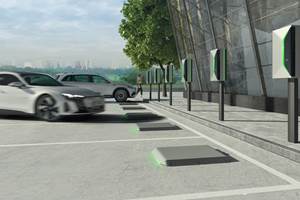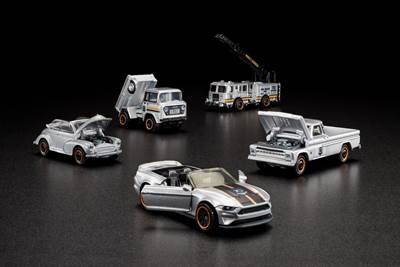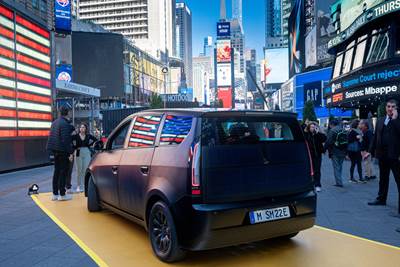on McLaren & materials, start-up thinking, EVs & ICEs, ADAS issues, supply chain, & Prius is back in a good way
A look at a composite-intensive car. . .why legacy OEMs need a new mindset. . .don’t count out internal combustion engines yet. . .a scooter and surfboard. . .EV owners dissatisfied with service. . .ADAS still seems iffy for many. . .global supply chain concerns. . .the 2023 Prius
McLaren Material Tribute
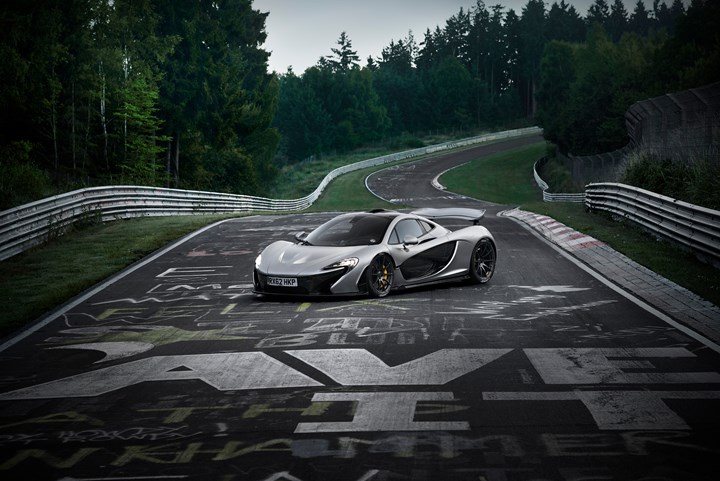
The McLaren P1: how many cars look this good 10 years after? (Image: McLaren)
The McLaren P1 hypercar was introduced at the Geneva International Motor Show 10 years ago this month.
The vehicle, of which there were 375 hand-built at the McLaren Production Centre in Woking, UK, is a hybrid, combining a 3.8-liter (or “litre”) V8 and an electric motor that combined to provide a system horsepower of 903.
The construction of the vehicle took 17 days and 82 technicians.
Nothing = Nothing
Because the engineers focused on mass reduction, the vehicle weighs just 3,285 pounds.
Then-chief design engineer Dan Parry-Williams said, “We followed the old Colin Chapman diktat that ‘nothing is as light as nothing.’ Unnecessary components were removed. If you can create mouldings that do as many jobs as possible, you have fewer parts and less weight. I also hate brackets and nuts and bolts. We ruthlessly removed them when at all possible.”
(Arguably, “I also hate brackets and nuts and bolts. We ruthlessly removed them when at all possible” could be a diktat for designers and engineers across the industry today, all of whom must be zealously focused on chasing grams.)
Given the horsepower and the mass, the P1 goes from 0 to 62 mph in 2.8 seconds.
(Nearly) Complete Composites
On the subject of materials, the P1 is carbon-fiber intensive.
As in carbon fiber body panels including:
- Front clamshell
- Rear clamshell
- Doors
- Hood
All these panels have a mass of 211.1 pounds.
They are attached to the central “MonoCage”: a carbon-fiber tub.
The roof is made with 2.4-mm thick, chemically toughened glass.
The exhaust system is produced with the nickel-based superalloy Inconel.
And the carpet on the inside?
There is none. It was determined to be unnecessarily heavy.
Parry-Williams: “It’s fast on the racetrack but still fast, comfortable and refined on the road.”
That “comfortable and refined” is probably a relative assessment.
Consider
Ten years on and it still looks contemporary.
///
There Are Start-Ups. . .and Then There Are Start-Ups

Dr. Doron Myersdorf, CEO of StoreDot, thinks more OEM execs need to think like they’re at start-ups. (Image: StoreDot)
“We are working with many global OEMs and it’s clear that some are already changing their mindset to adopt advanced battery technologies faster. But not every OEM behaves like this, and I believe the entire EV industry will benefit from accelerating its processes and timelines if we are going to collectively undertake the seismic shift to electrification that the world needs.”
That’s Dr. Doron Myersdorf, CEO of StoreDot, a company that describes itself as having “revolutionized the conventional Li-ion battery by designing and synthesizing proprietary organic and inorganic compounds, optimized by Artificial Intelligence algorithms, making it possible to charge an EV in under ten minutes.”
It plans to start delivering product in 2024.
It is working with companies including Daimler, VinFast, Volvo Cars, and Polestar. It says 15 global automotive manufacturers are evaluating its “XFC”—Extreme Fast Charge—batteries.
Myersdorf continued:
“With a typical 5-year cycle to implement any new battery technology, we are encouraging global automotive manufacturers following traditional processes to adjust their methods and mindset to more agile business practices when evaluating and implementing innovative technologies.”
Like XFC.
He admitted:
“Of course, car makers must not ignore crucial elements such as safety and reliability testing, which are a given.”
And cautioned:
“But in my experience, some OEMs are still rigidly sticking to testing regimes that hinder the ability to take advantage of battery breakthroughs. Some parts of the automotive industry are currently being held back and will continue to be so unless we all adopt the agility of start-up concurrent engineering practices.”
Some Fresh Thinking Fails
While not a start-up, StoreDot was established in 2012, which is fairly young by automotive company standards (Tesla was founded in 2003).
While there might be something to be said of a “start-up” mindset, apparently the U.S. Bureau of Labor Statistics has found that
- ~20% of start-ups fail within the first two years of operation
- 45% during the first five years
- 65% during the first 10 years
And the number that go beyond 15 years? About 25%.
Not all start-up thinking is beneficial.
///
Combustion Development to Continue at BMW?
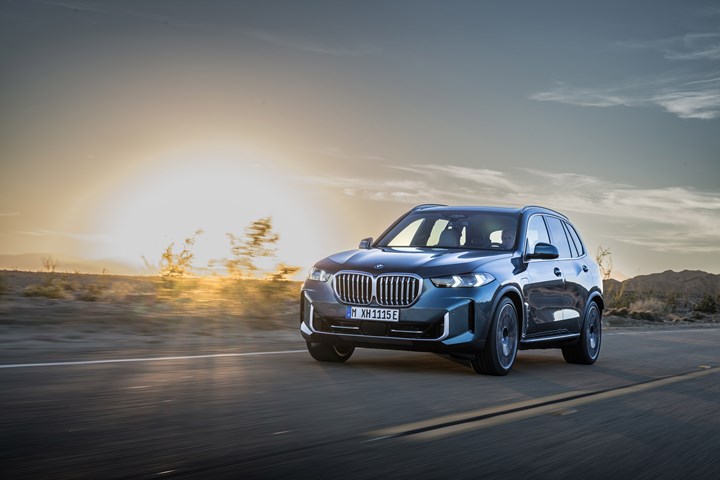
2024 BMW X5 xDrive50e is a plug-in hybrid. It offers a maximum system output of up to 483 hp and 516 lb-ft of torque while permitting a preliminary estimated electric-only range of up to 40 miles. (Image: BMW)
Last week the German business newspaper Handelsblatt reported:
“Despite all the commitments to the electric car, BMW is still planning to use combustion engines for a long time.”
It continued:
“The Handelsblatt learned from corporate circles that the X-series cross-country vehicles will also be built with petrol and diesel engines well into the coming decade. To this end, the models for the period after 2027 are to be further developed on a new vehicle platform that enables all drive concepts.”
Most of the BMW X-series vehicles--X3, X3 M, X5, X5 M and X7 Sports Activity Vehicles; the BMW X4, X4 M, X6 and X6 M Sports Activity Coupes; and the BMW XM—are produced at the BMW Manufacturing plant in Spartanburg, South Carolina. The X1 and X2 are produced in Regensburg, Germany.
So we asked a BMW spokesman about the plans, and he noted that while MINI and Rolls Royce (yes, both under the BMW umbrella) have announced they’re going fully electric early in the 2030s, there has been no announcement about BMW’s full switch to BEV.
Take a Breath
To be fair to BMW, a few days before that German newspaper report Honda Motor chief executive Toshihiro Mibe told Reuters he thinks combustion engines could be running in 2040 and beyond, although Honda is making an aggresive transformation from ICEs. And in late January GM announced an investment of $854-million for the production of a new V8. And. . . .
It isn’t game over for ICEs. By any means.
But let’s face it: When OEMs announce something in the EV space they get a whole lot more attention—including attention from Wall Street—than they do for something related to vehicles powered by gasoline.
///
Surf’s Up

A scooter and a surf board brings to mind The Beach Boys. In 1963 the band released the album Surfer Girl, which includes the song “In My Room.” So bringing this back to the German scooter modified by an Austrian shop: in 1983 The Beach Boys released “Ganz allein,” a German rendition of “In My Room.” (Image: BMW)
Speaking of BMW and EVs. . .
The BMW CE 04 is an electric scooter. It has a maximum output of 42 hp. It has a range of ~81 miles.
It is the sort of thing to drive around town.
Or, in the BMW CE 04 Vagabund Moto Concept—a collaboration between BMW Motorrad Austria and customizer Vagabund Moto GmbH of Graz, Austria—to the beach.
Paul Brauchart, founder and managing director of Vagabund Moto GmbH:
“Everyone defines the mobility of the future in their own individual way. With the BMW CE 04 Vagabund Moto Concept, we now present our own idea of a stylish and multifunctional urban e-scooter that shows just how mobility needs are as individual as each personality. We haven’t reinvented the wheel, but we have taken a new look at function. We call it drawing on the synergies between functionality and aesthetics in a way that is suitable for everyday use.”
Surfing Metaphorically
Oliver Balzer, head of BMW Motorrad Austria.:
“The surfboard isn’t just a piece of sports equipment: it’s also a metaphor for a sustainable urban lifestyle. The BMW CE 04 Vagabund Moto Concept combines work, leisure and individual flair, demonstrating that there needs to be no contradiction between any of these areas.”
As you may recall from geography class, Austria is land locked. Not the sort of place you might imagine surfing occurs.
Seems that there is surfing done in places like on the river Mur in Graz and on the Almkanal in Salzburg.
///
EVs: They Still Need to Be Fixed
One of the benefits of electric vehicles is that because there are fewer mechanical parts compared to an ICE vehicle, there is reduced maintenance. And that means fewer visits to the $ervice center.
However. . .
The J.D. Power 2023 U.S. Customer Service Index (CSI) Study released last week—which measures how satisfied owners are with the vehicle service they receive at dealer service centers—shows a year-over-year decline in satisfaction.
The first time such a thing has happened in 28 years.
Why?
EVs.
Service satisfaction is 42 points lower for EVs than ICEs.
Reasons:
- Recall rates for EVs are more than double than those for ICE vehicles
- Service advisor knowledge is lower
Chris Sutton, vp of Automotive Retail at J.D. Power:
“As the electric vehicle segment grows, service is going to be a ‘make or break’ part of the ownership experience.
“The industry has been hyper-focused on launches and now these customers are bringing their electric vehicles in for maintenance and repairs.”
Yes, it may be exciting to get a new EV. Evidently the after-the-sale return to the dealership isn’t as exhilarating.
Sutton:
“As training programs for service advisors and technicians evolve, EV service quality and customer experience must address both the vehicle and the unique customer needs. The EV segment has the potential to spur massive convenience improvements in how customers service their vehicles—but we’re not seeing the benefits yet.”
///
A Tech Too Far?
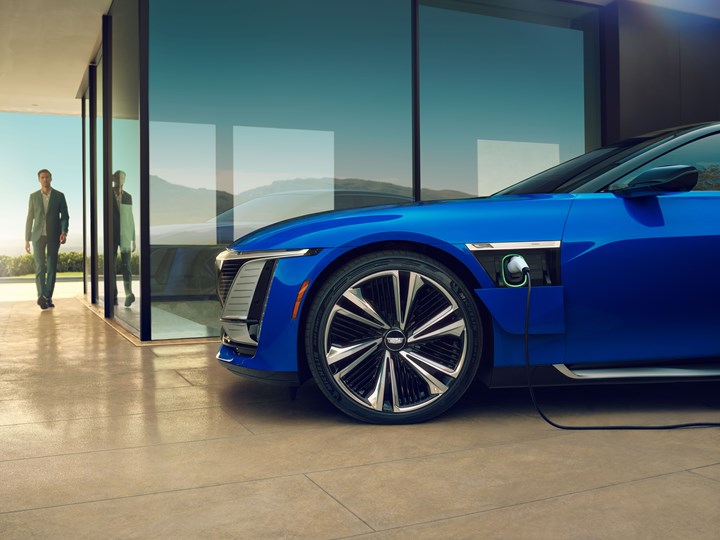
The Cadillac CELESTIQ electric vehicle will be available with the GM Ultra Cruise ADAS system that is engineered to “ultimately enable hands-free driving in 95% of all driving scenarios.” Sensors include a camera on top of the steering column to observe the driver, seven long-range cameras on the exterior, four short-range radars, three long-range radars, and a lidar system. Control is provided by systems on a chip (SoCs) developed by Qualcomm. (Image: Cadillac)
“The business case for ADAS is currently unclear due to low consumption levels. Pricing models are difficult to establish as many consumers remain skeptical and unwilling to pay for the technology (Stigloe et al., 2022). A better understanding of how many consumers shut off the ADAS features in their vehicles is needed to appropriately model the business case for pricey subscription models.”—"State of ADAS, Automation and Connectivity,” Naseeb Souweidane and Brett Smith, Center for Automotive Research, 2023
The first rule of the auto industry, a wise man once told me, is:
“Always make money.”
Given that finding by the CAR researchers, it would seem that advanced driver assistance systems (ADAS), which many figure are fait accompli, may be up against consumer resistance, which might violate that rule.
What’s In It For Them?
The researchers note: “When implemented correctly, ADAS can provide an attractive incentive to consumers. However, adoption of ADAS will not solely come from the excitement surrounding the technology. Consumers will need to believe in the practical benefits of ADAS. Safety is a pivotal selling point, but ADAS must also prove it can make the driving experience more manageable and less burdensome.”
Which sounds like there is a lot of work to do by the OEMs on ADAS. . .
What About Autonomy?
Which brings us to another of the techs that Souweidane and Smith consider in this fascinating study: fully automated vehicles, a.k.a., SAE Level 4 and Level 5 (per SAE: “These automated driving features will not require you to take over driving”).
Putting aside the technical viability and capabilities of the lidar, cameras, high-definition maps, radar, ultrasonics, neural nets, GPUs, and other elements needed for automated driving capability (Souweidane and Smith note: “There is no consensus on technologies needed to best support AV development,” which indicates that there may be some cul-de-sacs on the road to AV deployment), again, what’s the business situation?
“Consumer skepticism toward AVs is high,” they write.
Not good.
Costs Make It Commercial--Maybe
Still, the authors note that this may not be an issue of, in effect, having an AV in one’s driveway: “many projections for AV pricing suggest AVs will be more costly than traditional vehicles and sold at price points outside the price range of comparable consumer segments.”
This could mean AVs are more of a commercial play, as in ridesharing services.
What’s more: “The low operating costs associated with using an AV for ridesharing may lead to more favorable pricing”—pricing for the service, not the vehicle—“shifting consumer preferences toward ridesharing and away from private ownership.”
They also point out that the pandemic threw a spanner in the works of the interest people may have had in riding in a shared vehicle.
The ODD: Restrictive, Not Unusual
There is something called the “Operational Design Domain.” ODD basically describes the boundaries within which an AV can operate. This can range from the weather (e.g., a snowstorm) to geography (e.g., open roads but not city streets or vice versa). Level 4 has ODDs. Level 5 is unrestricted.
But getting back to the financial viability (which can be even more limiting than a hurricane), know that Waymo has laid off 8% of its employees so far this year; last week Reuters reported that Gil West, COO of GM’s Cruise Automation, said the AV company would “continue to drive costs out as we move forward” and you can speculate as to what that means.
The CAR researchers write there have been various Level 4 business models deployed, ranging from “freight hauling to food delivery services to last-mile deliveries.” Not dropping the kids off at school. Not unrestricted travels.
They note: “Promoting business cases suitable for similar contexts would yield more immediate returns than scaling towards Level 5 in an unlimited ODD with an exceptionally distant timeline.”
For companies that are measured by the quarter (at longest) that “exceptionally distant timeline” may simply make Level 5 AVs a tech too far to meet the first rule of the auto industry.
///
Supply Chain Concerns & Electrification Issues
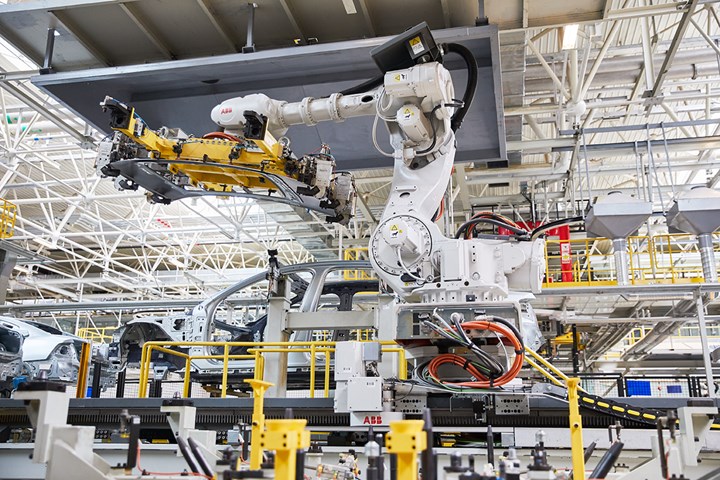
Automation is an enabler, but supply chain constraints still hobble global manufacturing. (Image: ABB)
Supply chain continues to be a massive issue across the automotive manufacturing landscape—a major problem.
Asked about the top manufacturing challenges, the responses to a global survey conducted by Advanced Manufacturing Solutions and ABB were “Supply chain disruption” for:
- 52% in Asia
- 70% in North America
- 64% in Europe
“Rising material & component prices” were the second-most challenging in Asia, at 42%, followed by “Labor costs & skills shortages” at 31%.
North America had the same concerns as those in Asia, but the two categories tied at 51%.
In Europe, “Rising energy costs” were the second-biggest challenge, at 46%, followed by “Rising material & component prices” at 36%.
Another take on the challenge question was to look at how both OEMs supplier tiers thought of them.
And for all the business types, “Supply chain disruption” topped the list:
- OEM: 64%
- Tier 1 (system): 57%
- Tier 2 (component): 57%
- Tier 3 (material): 61%
About EV Achievement
That supply chain issue is likely to have a sizable impact on companies around the world being able to reach the various 100% electric vehicle regional requirements between 2030 and 2040.
Asked about the likelihood of reaching the targets:
- 41% said “Possibly, but not by the target dates”
- 28% said “Yes, but it won’t be easy”
- 18% said “No, I don’t see this happening ever”
- 11% said “Yes, definitely”
- 2% said “I’m not sure”
So while the majority thinks full EVs will happen, only 39% think the target will be achieved.
Of course, the only ones who will inevitably be right are the 2%.
Chargers & Prices
One other finding of interest in the “Automotive Manufacturing Outlook Survey 2022”: Asked about the top challenges of going to electric, there was consistency across company types for the top two inhibitors.
“Lack of charging infrastructure” was the number-one challenge for 28% of OEMs, 19% of Tier 1 suppliers, 32% of Tier 2 suppliers, and 31% of Tier 3 suppliers.
“High EV prices” were cited by 16% of OEMs, 15% of Tier 1s, 21% of Tier 2s, and 14% of Tier 3s.
Interestingly, as for the third concern, “Slow advances in EV range/charging” was cited by both OEMs (12%) and Tier 1s (12%).
“Consumer resistance” was selected as the third biggest challenge by Tier 2s (13%) and Tier 3s (14%).
///
2023 Toyota Prius Limited AWD

The 2023 Toyota Prius: Style meets efficiency. (Image: Toyota)
You’ve got to imagine that a few years ago in Toyota City a group of executives met and came to the conclusion that the Prius, the vehicle with a powertrain that was as transformative to propulsion as anything in decades, had seemed to stall.
There were four generations of the hybrid in the U.S. market—starting as model years 2001, 2004, 2010, and 2015—and there had even been size variants, such as the Prius v, a larger version, and the Prius c, smaller.
But things weren’t going so well.
A Look Back
To arbitrarily go back 10 years (yes, I know it is 2023, but for purposes of a full year we’ll use 2022), there were 236,659 Priuses sold in the U.S.
Then, five years forward to 2017, the number was down to 108,662.
And then in 2022 the Prius numbers were, to be generous, sad: 36,919.
Certainly, across the industry sales were not good in 2022, but things weren’t going swimmingly in 2021 either, and that year Toyota managed to sell 59,010 Priuses. That represents a decline of 37.6% from ‘21 to ‘22—and realize that the Avalon had a year-on-year decline of 37.4% and Toyota took it out of the lineup.
It is worth noting that in 2022 there were 11 other Toyota hybrid models, so the Prius (which was also available as a Prime, or plug-in) had some showroom competition.
But it is widely accepted that the redesign of the fourth-generation Prius wasn’t so much polarizing as it was off-putting, which could have contributed to its decreased contribution to sales.
So undoubtedly those Toyota execs decided to do something bold (they could have probably speculated on a continued decline in sales, but that 84.4% decline from 2012 to 2022 is really hard to imagine), and the designers and engineers who worked on the fifth-generation vehicle delivered.
There are two ways of assessing a vehicle: Subjectively and objectively.
One is about taste. The other about metrics.
By the Numbers
Let’s take the second first.
The 2023 Prius Limited AWD has a 150-hp 2.0-liter four-cylinder engine, a 111-hp permanent magnet AC synchronous motor that also operates as a generator during regenerative braking, and a 40-hp permanent magnet motor in the back for electronic on-demand AWD.
The total system horsepower is 196.
The car—and it is quite clearly a car, not something pretending to be a crossover—is 181.1 inches long, 70.2 inches wide, 56.3 inches wide, and it has a 108.3-inch wheelbase.
The EPA passenger volume is 91.2 cubic feet. The cargo volume behind the second row is 20.3 cubic feet.
All of which is to say that this is pretty much in line with a compact car dimensionally, and if the hybrid components are removed, the engine pencils with a straight ICE compact.
But here are a set of numbers that take it beyond the norm: 49/50/49.
Those are the city/highway/combined miles per gallon for the Prius.
And this is an AWD car.
Going Far
According to AAA, the day this is being written, March 10, 2023, the U.S. average for a gallon of gas is $3.474. A year ago it was $4.318.
So let’s take an average of $3.896.
The Prius has an 11.3-gallon gas tank. To fill it would cost $44.02.
Based on the combined mileage number, that would take the car 539 miles. (I figured 11 gallons because you wouldn’t want to run it to dry.)
And one number that is key to know in this context is $35,865, the base MSRP for the Limited AWD model.
Point of View
But to the subjective.
As regular readers of on Automotive know, there have been several cars, trucks and crossovers in my driveway during the past many months.
Again, while this is completely anecdotal, I can say that there has been no vehicle that has garnered more looks by people—young, old, in-between—than the ’23 Prius.
I think the styling is first-rate. And apparently there are many others who potentially share that perspective.
The Prius is back.
It has the subjective and objective stuff that make it a stand-out vehicle.
Related Content
Eliminating Automotive Defects Per Million With Automated Visual Inspection
This automotive manufacturer virtually eliminated PPM defect complaints after implementing an automated visual inspection system at its facility.
Read MoreSandvik Coromant on Acquisitions: Solutions Entail More Than the Tool
A Q&A with global president Helen Blomqvist explores the cutting tool maker’s acquisition of CAM software companies and how this connects to, among other things, electric vehicles.
Read More4 Steps to a Cobot Culture: How Thyssenkrupp Bilstein Has Answered Staffing Shortages With Economical Automation
Safe, economical automation using collaborative robots can transform a manufacturing facility and overcome staffing shortfalls, but it takes additional investment and a systemized approach to automation in order to realize this change.
Read MoreSiemens and Mahle Partner to Develop Wireless EV Charging
Mahle will contribute its experience as an automotive supplier and Siemens will use its expertise in the field of charging infrastructure to develop wireless charging stations for electric vehicles.
Read MoreRead Next
on Rivian, ICEs, Three-wheelers, AI for autonomous driving, Honda Pilot
Rivian is still gaining traction. . .Renault, Geely and Amoco don’t think ICEs are done. . .three-wheelers for vastly different applications. . .Honda’s rugged SUV. . .
Read Moreon Casting, Hydrogen, the Future, Mobility, Bikes, & More
Tesla and Matchbox. . .hydrogen for trains. . .Ford looks at the future. . .mobility for the disabled. . .stealing bikes in Amsterdam. . .Toyota racks up the patents. . .Volvo S60 reviewed. . .
Read Moreon Sion's end, vehicle ratings, brand loyalty, BEV big rigs, Toyota Sequoia, & Stellantis leverages resources
Why Sono Motors ended Sion. . .how OEMs are rated by CR. . .Tesla has lots of loyalists. . .Conti uses interior cameras for identifying drivers. . .using alternative power in the Port of Los Angeles. . .Toyota’s top-of-the-line Sequoia. . .Stellantis leverages manufacturing base
Read More
.jpg;width=70;height=70;mode=crop)








.png;maxWidth=300;quality=90)






.png;maxWidth=300;quality=90)








